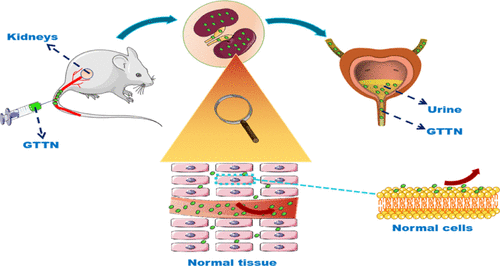当前位置:
X-MOL 学术
›
Mol. Pharmaceutics
›
论文详情
Our official English website, www.x-mol.net, welcomes your
feedback! (Note: you will need to create a separate account there.)
Acute and Subacute Toxicity Study of Graphene-Based Tumor Cell Nucleus-Targeting Fluorescent Nanoprobes.
Molecular Pharmaceutics ( IF 4.5 ) Pub Date : 2020-06-01 , DOI: 10.1021/acs.molpharmaceut.0c00380 Wenchao Gao 1, 2 , Junfeng Zhang 1 , Qianghua Xue 1 , Xiaofeng Yin 1 , Xuelian Yin 1 , Chenchen Li 1 , Yanli Wang 1, 2
Molecular Pharmaceutics ( IF 4.5 ) Pub Date : 2020-06-01 , DOI: 10.1021/acs.molpharmaceut.0c00380 Wenchao Gao 1, 2 , Junfeng Zhang 1 , Qianghua Xue 1 , Xiaofeng Yin 1 , Xuelian Yin 1 , Chenchen Li 1 , Yanli Wang 1, 2
Affiliation

|
Graphene-based tumor cell nuclear targeting fluorescent nanoprobes (GTTNs) were synthesized in our laboratory as a kind of nanomaterial and showed good performance for both in vivo and in vitro imaging. GTTNs directly cross the cell membrane and specifically target the tumor cell nucleus via a cell membrane permeability targeting (CMPT) mechanism, which takes advantage of the increased permeability of the tumor cell membranes. GTTNs with a CMPT mechanism achieve high targeting efficiency in tumor tissues. With the tumor cell nucleus-targeting characterization, the GTTN distinguishes tumor cells at the single-cell level and recognizes the tumor tissue interface in a very early stage and shows great potential in clinical applications. Toxicity studies are extremely critical for clinical applications. Therefore, we studied the acute and subacute toxicity of GTTNs using an in vivo method and examined the following experimental indicators: mouse body weight, organ coefficients, serum biochemical parameters, and histological changes. The results showed that there were no significant differences in any indicators between the experimental and control mice. We also used an in vitro method to study the cytotoxicity of GTTNs in GES-1 (gastric epithelial cell) cells. Surprisingly, the results demonstrated over 80% cell viability when the incubation time reached up to 72 h under a 200 mg/L concentration of GTTNs, which indicated that GTTNs had low cytotoxicity. GTTNs barely showed any acute or subacute toxicity or cytotoxicity in vivo and in vitro, respectively, which supports their use for clinical applications.
中文翻译:

基于石墨烯的肿瘤细胞核靶向荧光纳米探针的急性和亚急性毒性研究。
在我们的实验室中,以石墨烯为基础的肿瘤细胞核靶向荧光纳米探针(GTTN)被合成为一种纳米材料,并且在体内和体外成像方面均表现出良好的性能。GTTN直接穿过细胞膜,并专门通过以下途径靶向肿瘤细胞核细胞膜通透性靶向(CMPT)机制,它利用了肿瘤细胞膜通透性的提高。具有CMPT机制的GTTN在肿瘤组织中实现高靶向效率。GTTN具有肿瘤细胞核靶向特性,可在单细胞水平上区分肿瘤细胞,并在非常早期就识别肿瘤组织界面,在临床应用中显示出巨大的潜力。毒性研究对于临床应用至关重要。因此,我们在体内研究了GTTN的急性和亚急性毒性方法并检查以下实验指标:小鼠体重,器官系数,血清生化参数和组织学变化。结果表明,实验小鼠和对照小鼠之间的任何指标均无显着差异。我们还使用了一种体外方法来研究GTTNs在GES-1(胃上皮细胞)细胞中的细胞毒性。出人意料的是,当在浓度为200 mg / L的GTTNs下孵育时间长达72小时时,结果表明细胞活力超过80%,这表明GTTNs具有低细胞毒性。GTTN分别在体内和体外几乎没有显示任何急性或亚急性毒性或细胞毒性,这支持了它们在临床上的应用。
更新日期:2020-07-06
中文翻译:

基于石墨烯的肿瘤细胞核靶向荧光纳米探针的急性和亚急性毒性研究。
在我们的实验室中,以石墨烯为基础的肿瘤细胞核靶向荧光纳米探针(GTTN)被合成为一种纳米材料,并且在体内和体外成像方面均表现出良好的性能。GTTN直接穿过细胞膜,并专门通过以下途径靶向肿瘤细胞核细胞膜通透性靶向(CMPT)机制,它利用了肿瘤细胞膜通透性的提高。具有CMPT机制的GTTN在肿瘤组织中实现高靶向效率。GTTN具有肿瘤细胞核靶向特性,可在单细胞水平上区分肿瘤细胞,并在非常早期就识别肿瘤组织界面,在临床应用中显示出巨大的潜力。毒性研究对于临床应用至关重要。因此,我们在体内研究了GTTN的急性和亚急性毒性方法并检查以下实验指标:小鼠体重,器官系数,血清生化参数和组织学变化。结果表明,实验小鼠和对照小鼠之间的任何指标均无显着差异。我们还使用了一种体外方法来研究GTTNs在GES-1(胃上皮细胞)细胞中的细胞毒性。出人意料的是,当在浓度为200 mg / L的GTTNs下孵育时间长达72小时时,结果表明细胞活力超过80%,这表明GTTNs具有低细胞毒性。GTTN分别在体内和体外几乎没有显示任何急性或亚急性毒性或细胞毒性,这支持了它们在临床上的应用。











































 京公网安备 11010802027423号
京公网安备 11010802027423号